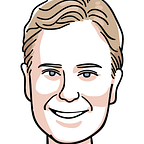Unconscious biases boost your leadership thinking; if you’re conscious of them.
Seven things, plus or minus two. That’s how much information the average human brain can keep front-of-mind at any one time. Beyond that — you’re swamped.
With such limited capacity, how do we handle complex problems? The answer, strangely, is not we have massive brains. Although that’s true. The answer is that humans have developed some very efficient work arounds. What Gerd Gigerenzer and Daniel Goldstein call “fast and frugal” rules of thumb. These allow our brains to analyze information, sort choices, and arrive at decisions in fractions of a second. These fast and frugal rules are otherwise known as unconscious biases.
Wherever there’s been a decision, there’s been an unconscious bias or two….or three….or maybe even four! Unconscious biases are the high-speed sub-routines that help us navigate our world.
Not flaws. Adaptations.
Unconscious biases are facts of our existence. Researchers regard them not as flaws in our thinking but as cognitive features. They’re evolutionary adaptations that have allowed humanity to strive and thrive. Through awareness, and challenge where necessary, we can turn those features into strategies.
Think of them as influencing three essential areas of decision making: what we pay attention to, the way we make an estimate, how we spot a trend. Each is a manifestation of those high-speed sub-routines in action.
What we pay attention to.
When something is vivid we assume that it’s valid! Information that is big and dramatic is more memorable. We recall it easily. This information is dramatic. If unchallenged though, it crowds out less flashy information that might be more relevant.
The way we make an estimate.
How long will it take? How much with it cost? How will he/she react? Life is full of estimates. These estimates come from unconscious biases known as Anchoring Biases. Think of them as educated guesstimates straight from the subconscious. These guesstimates create an anchor point. Our rational minds seek to come up with a ‘reasoned estimate’, but in reality we never move far from that initial subconscious anchor.
How we spot a trend.
We are superb at spotting patterns; whether in the trends of the market or the trends of a co-worker’s behavior. Once we establish and ‘see’ a pattern, it becomes a fundamental element in our decision making. This provides shorthand logic to help us reach conclusions more quickly. It’s also inflexible. Once we spot a ‘pattern’, it becomes difficult for us to un-spot it, even when presented with new evidence.
Illusion or reality? Can we always trust the evidence of our eyes?
To try this out, take a look at the Gestalt illusion below. What do you see? Is it a rabbit or a duck? One pattern will be stronger for you. If you saw the rabbit first, notice how you keep on seeing it as a rabbit, even though you are aware it could also be a duck. And vice versa, if you saw the duck first, then you’ll be struggling to remind yourself there is also a rabbit! It’s as if you have to drag your perception from one image to the next, only to have your subconscious then snap it back to that first impression. A case of ‘if it walks like a duck and quacks like a duck, then it’s still a rabbit!’
Here are a selection of typical unconscious biases. How might they be influencing your leadership decisions, or the decisions of others?
The Halo Effect.
Have you ever seen a movie advertised with a certain actor, and immediately thought “Gosh — if he/ she is in it, then it must be good!”
Nine times out of ten, the name in lights over the main marquee will lead us to a great movie. Every so often it won’t.
When have you found yourself dazzled by someone or something’s undeserved halo?
Choice Overload.
Lots of choice is good, right? Wrong.
Professor Sheena Iyengar and her team demonstrated that too much choice overwhelms us. Too much choice makes it complicated. It also makes us dedicate precious mental resources to disentangling the decision, when we prefer life to be simple.
Even though we think we’re being helpful by offering lots of choices, people are happier when we narrow things down for them.
Are you over-complicating the lives of those you lead, serve, or sell to by offering too much choice?
The Negativity Effect.
What do you remember more? The stuff that worked well, or flopped badly? Probably the latter.
For practical evolutionary reasons, we’re hardwired to remember the things that hurt. The ‘School of Hard Knocks’ is a proven and effective teacher. It also limits our willingness to experiment and take chances when the need arises.
Do you and your team take steps to experiment and innovate, or do you prefer the proven path?
Biases help us navigate. Like all GPS devices, they are best used with self-awareness.
Once we’re aware of how biases might be helping (or hindering) our leadership practice, and the practice of others, we can take steps to work with them:
When a person or product appears too good to be true, do we ask the searching questions that reveal the reality?
When paralyzed in a decision due to overwhelming choice, do we create sub-categories that cut those choices down to size?
Do we encourage others to reflect on their successes, or do we let the Negativity Effect build barriers against progress?
Leadership life is hectic. It can create an all-consuming load on our ability to think and to make clear decisions. Unconscious biases help us prioritize and respond. They can create a valued life-boat in a sea of data.
If we are conscious of them.
fassforward is a consulting firm that helps global leaders change the conversation about culture, leadership and customers. We build leadership and change programs for Fortune 500 clients.
Follow fassforward on LinkedIn and Twitter, or connect with us at hello@fassforward.com.
